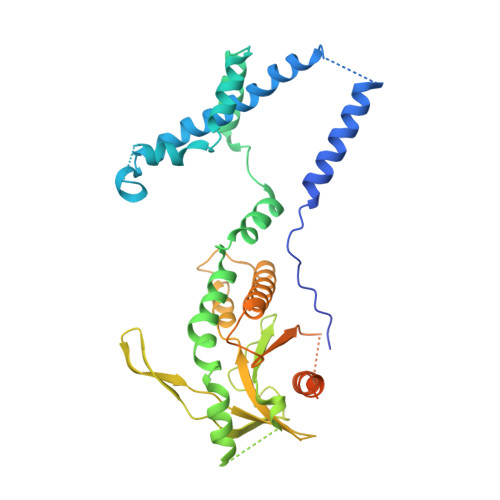Cryo-EM structures of STING reveal its mechanism of activation by cyclic GMP-AMP.
Shang, G., Zhang, C., Chen, Z.J., Bai, X.C., Zhang, X.(2019) Nature 567: 389-393
- PubMed: 30842659
- DOI: https://doi.org/10.1038/s41586-019-0998-5
- Primary Citation of Related Structures:
6NT5, 6NT6, 6NT7, 6NT8 - PubMed Abstract:
Infections by pathogens that contain DNA trigger the production of type-I interferons and inflammatory cytokines through cyclic GMP-AMP synthase, which produces 2'3'-cyclic GMP-AMP (cGAMP) that binds to and activates stimulator of interferon genes (STING; also known as TMEM173, MITA, ERIS and MPYS) 1-8 . STING is an endoplasmic-reticulum membrane protein that contains four transmembrane helices followed by a cytoplasmic ligand-binding and signalling domain 9-13 . The cytoplasmic domain of STING forms a dimer, which undergoes a conformational change upon binding to cGAMP 9,14 . However, it remains unclear how this conformational change leads to STING activation. Here we present cryo-electron microscopy structures of full-length STING from human and chicken in the inactive dimeric state (about 80 kDa in size), as well as cGAMP-bound chicken STING in both the dimeric and tetrameric states. The structures show that the transmembrane and cytoplasmic regions interact to form an integrated, domain-swapped dimeric assembly. Closure of the ligand-binding domain, induced by cGAMP, leads to a 180° rotation of the ligand-binding domain relative to the transmembrane domain. This rotation is coupled to a conformational change in a loop on the side of the ligand-binding-domain dimer, which leads to the formation of the STING tetramer and higher-order oligomers through side-by-side packing. This model of STING oligomerization and activation is supported by our structure-based mutational analyses.
Organizational Affiliation:
Department of Pharmacology, University of Texas Southwestern Medical Center, Dallas, TX, USA.















